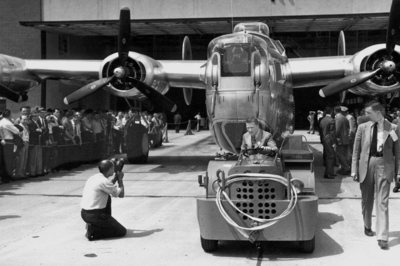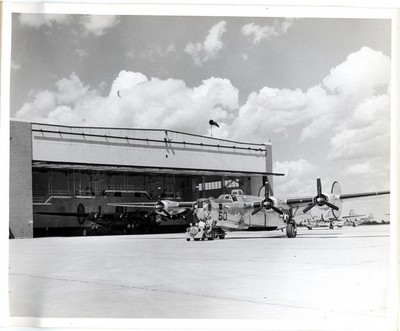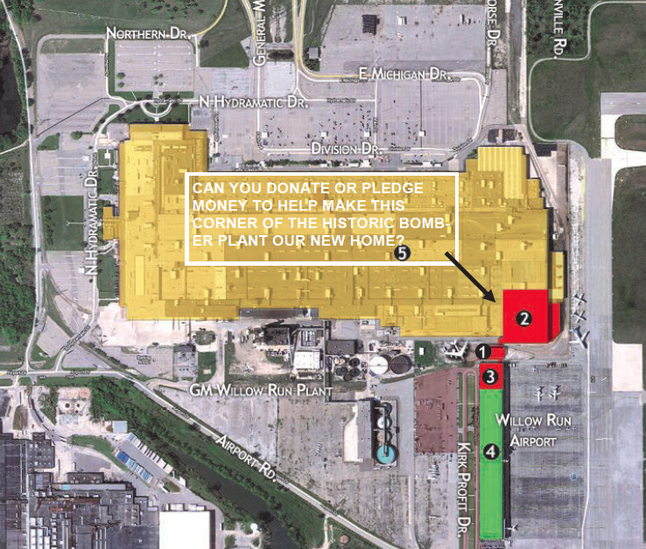Willow Run bomber plant: Museum short $4.7M to save portion from September demolition
As a September demolition date looms for the former Willow Run Powertrain facility in Ypsilanti Township, fundraising efforts to save a portion of the attached Willow Run bomber plant are about $4.7 million short.
With two weeks until an Aug. 1 deadline to come up with the funds, the Yankee Air Museum is pursuing large individual and company donors across the country to make up the difference.

The last Ford bomber, the B-24 "Liberator" rolls out of the Willow Run plant with Henry Ford II driving the tow in June 1945. The plant was built with an eye toward wartime production in 1940.
Eck Stanger | The Ann Arbor News
“(The Willow Run bomber plant) was the focal point of the entire arsenal of democracy,” Norton said. “Detroit won the war and we can’t let that story die.”
Should the museum fail to reach its $6 million goal, the entire bomber plant will be razed with the rest of the Powertrain facility.
Renovation too costly
The entire facility contains 4.6 million square feet and was being marketed to industrial companies for reuse by its owner, Revitalizing Auto Communities Environmental Response, or RACER, Trust.
In the wake of General Motors' ’s 2009 bankruptcy, the RACER Trust was formed by the federal government in 2011 to liquidate GM’s holdings and clean up the environmental contamination at its 89 sites across 14 states.
In Michigan, the largest of those sites is the Willow Run facility.
With the mission of helping communities hurt by the closure of the GM plants, RACER Trust has a strict set of criteria that future buyers have to meet before it can sell a property.
“We feel we only get one shot,” said Bruce Rasher, redevelopment manager for RACER Trust.
At first, most of the offers for the Willow Run plant would have resulted in companies demolishing the facility for the scrap metal and then abandoning the property, Rasher said.
After two and a half years in which they fielded 40 inquiries from interested parties but got no commitments, RACER Trust officials recently announced that the entire building would be torn down.
The Willow Run property will now be marketed to investors as vacant land — a move that Rasher thinks will make a huge difference in attracting interest.
Renovating the facility would exceed the cost of new construction, he said.
It will also be cheaper for the trust to manage in the future, as the Willow Run site was the costliest for the trust to carry since it took over 2011.
To date, $15 million has been spent to provide heat, light and security, and to pay taxes on the facility. Electric bills for the plant cost on average $75,000 to $80,000 per month, as the building is not insulated.
Rasher said one party is seriously interested in the property, though the trust continues to market it to companies in the automotive, aerospace and defense and manufacturing sectors.
Rasher has high hopes for the site, as its access to the highway, rail system, Willow Run Airport and proximity to the University of Michigan, industries in southeast Michigan and Canada make it the “crown jewel” of properties the trust manages.
The bomber plant

B-24 "Liberator" bombers roll out of the Willow Run plant in Ypsilanti Township in 1945. The bombers were produced there by Ford Motor company from roughly mid-1942 until mid-1945.
Taken by Ford Motor Company and property of Yankee Air Museum
The section the museum is trying to save is 160,000 to 180,000 square feet of the original 3.5-million-square-foot bomber plant. That portion contains the two massive hangar doors where the new bomber planes rolled off the line and on to the tarmac.
Because the RACER Trust has been tasked with a long-term mission for the properties it controls, it is requiring the museum to front the funds for repairs for the bomber plant to ensure its success.
Norton said the trust is offering the section of the bomber plant to the museum at a “minimal cost” below the $6 million figure.
Originally, the trust asked the museum to front $8 million, Norton said.
Negotiations between the two parties dropped that to $6 million, as the trust re-engineered its demolition plan to preserve the electrical lines. Rewiring the electrical lines would have cost about $2 million, Norton said.
Norton said the total required by RACER Trust may be less in the end, as the trust is looking for ways to preserve some of the utility lines so the museum can reuse them.
“(The trust) has bent over backwards to make some changes to make this work for us,” Norton said. “They want to see this thing work. They’ve been very helpful.”
The Yankee Air Museum has established a website and an aggressive campaign in the approximate three months it was given to raise the $6 million: fliers, lawn signs and billboards have been drawn up with an image of "Rosie the Riveter" and the text “Save the bomber plant.”
- Donate online at savethebomberplant.org
“I’m very hopeful,” Norton said. “We are talking to a number of people that could put us up to that point right now … I’m confident but not over confident.”
Should the museum be successful in raising the funds, it would face a continued fundraising task to pay for a new heating system and renovation costs.
The museum may also be in a position to acquire one of the four remaining B-24 Liberator bombers produced at Willow Run that are still in existence if it acquires part of the bomber plant, Norton said.
Demolition details
RACER Trust is now reviewing bids from demolition contractors and expects demolition to begin in September. Officials estimate the work will take 12 to 18 months.
Rasher declined to disclose the cost of demolition. Through the contract agreement, the contractor will pay RACER Trust a lump sum for the right to demolish the building.
The value of the scrap metal in the former Powertrain plant is high enough that Rasher anticipates it will more than pay for the cost of demolition.
The contractor will be responsible for paying for the safe disposal of asbestos insulation materials that cover most of the steam pipes throughout the building.
Razing the building will also mean that thousands of pieces of equipment still inside the plant will be sold to the contractor. RACER Trust conducted three auctions to liquidate much of the equipment inside, but not all of it was sold.
The concrete slab that forms the building’s 83-acre footprint will remain intact during demolition — a vital measure to keep the 4.1 million gallons of industrial solvents, oils and chemicals that have spilled into the ground below from being disturbed. The average thickness of the slab is 12 inches.
The building’s storm water system underneath the slab is collecting the pollution as it seeps through the groundwater. The contaminated water is piped to a water treatment plant on the property — a system that will remain in place throughout demolition, said Grant Trigger, cleanup manager.
The trust has a $35.8 million budget to address the long-term environmental contamination on the site, which will continue after the sale of the property.

The portion of the former GM Willow Run Powertrain facility -- which is colored yellow -- that the Yankee Air Museum is seeking to buy is designated with the number two and is colored in red.
Courtesy of the Yankee Air Museum
Amy Biolchini covers Washtenaw County, health and environmental issues for AnnArbor.com. Reach her at (734) 623-2552, amybiolchini@annarbor.com or on Twitter.


Comments
15crown00
Fri, Jul 19, 2013 : 3:15 a.m.
Knock it down.Not worth saving.
Paul
Thu, Jul 18, 2013 : 10:46 p.m.
Just get rid of it, time marches onward.
Amy Biolchini
Thu, Jul 18, 2013 : 3:03 p.m.
During this effort to preserve about 5 percent of the Willow Run bomber plant and turn it into the Yankee Air Museum's new home, I keep being reminded of the National Museum of the U.S. Air Force at the Wright-Patterson Air Force Base in Dayton. ( http://www.nationalmuseum.af.mil/ ) Granted, that museum is much larger. But when it was built, the story has some similarities to what's going on with the bomber plant. The museum in Dayton was built in the 1960s for $6.5 million -- which came entirely from public contributions. The original facility was an 192,000-square foot building. Additions have been made since then to expand the complex to make the museum a destination spot for many people.
Greggy_D
Thu, Jul 18, 2013 : 5:09 p.m.
Don't forget the fantastic Air Zoo in Kalamazoo. They also recently expanded their facilities.
Greggy_D
Thu, Jul 18, 2013 : 2:31 p.m.
Since they are sitting on over $7 billion in endowment funds, you would think the University of Michigan would step in and form some sort of joint operation with the Yankee Air Museum.
Top Cat
Thu, Jul 18, 2013 : 4:25 p.m.
If the U of M got involved with the Yankee Air Museum, they would probably demand that illegal aliens get discounts on Museum admission.
Mike
Thu, Jul 18, 2013 : 1:26 p.m.
I would hope that Ford Motor Company would help with this project. Henry Ford was the owner of that property and the builder of that great plane that helped to keep this land free. For many of us baby boomers the bomber plant was our parents source of income. The impossible was made possible there. I know that I can not afford 4 million dollars but I will pledge what I can in my fathers name as he worked there to help keep this country free. I might even find a couple dollars to toss in as a veteran of a foreign war. ( Vietnam) That part of Ypsi? I was raised in that part of Ypsi. But 55 years ago that was the part of Ypsi to go to. With the right incentives, that could once again be the place to be.
Usual Suspect
Thu, Jul 18, 2013 : 12:15 p.m.
Perhaps some donations from overseas could help out, like the nations we saved with the B-24s that were built there. This plant was a big part of the reason we speak English instead of German or Japanese. It seems somebody would come forward and say, "Thank you" with some big checks.
nekm1
Thu, Jul 18, 2013 : 1:11 p.m.
Ford made a lot of money during the war, making planes at this plant! How about they kick in the 4.5 mil?
NSider
Thu, Jul 18, 2013 : 11:06 a.m.
The museum guys should just ask every past or present owner of a GM vehicle with a powertrain built there to contribute $1. Or maybe get the union (UAW) to contribute $1 for every hour of overtime worked in the plant? Perhaps $1 for every ton of toxic waste the demolition of the plant is going to create, to be paid by GM? I suspect any one of the 3 of those tariffs/taxes/fees would raise triple the amount needed.
Mike
Thu, Jul 18, 2013 : 8:40 p.m.
Hmmmm great idea.... That should be somewhere around 100 million dollars could be collected, for the transmissions built there. Another 50 million for the overtime .The toxic waste by the ton? Is 30 million ton of waste fair? Well 30 million in waste that looks like about 180 million dollars. oops Sorry there are not 100 million past or present owners still alive, I forgot that many of these people no longer are with us, many passed because of the overtime they worked, some passed due to the waste deposited there, a few went away because of transmission failure accidents. Darn, this is getting difficult.
Bubba43
Thu, Jul 18, 2013 : 11:01 a.m.
Good luck with getting the funds with the economy the way it is. Plus who wants to go to that part of Ypsi?
Paula Gardner
Thu, Jul 18, 2013 : 11:13 a.m.
That part of Ypsi does feel isolated, since the factory is empty - and the heavy industrial area isn't exactly a big tourist draw. But I think it makes sense to have the museum close to the airport. They've done a great job building the collection, and it feels like a natural fit once you're there.
NSider
Thu, Jul 18, 2013 : 11:07 a.m.
They could make it a stop on the Ann Arbor Connector route? Or maybe another stop on the wonderful Coleman Young People Mover?
PWJT8D
Thu, Jul 18, 2013 : 10:31 a.m.
I keep crossing my fingers. I'd hate to see Yankee lose out on this part of the facility. It's too bad the deadline could not be pushed back until after the Thunder Over Michigan air show. That has always been a profitable event for the museum.
Paul
Thu, Jul 18, 2013 : 10:51 p.m.
You see how much they want for tickets and parking for the air show ? Its way over priced, seen an air show in Hamilton ON last month, got free parking and shuttle bus to the airport and tickets were $30 for each adult. Yeah yeah, the Canadian gov. helps fund the air shows, well we wanted GWB for 8 years and big tax cuts for the filthy rich and that is what we got.
PWJT8D
Thu, Jul 18, 2013 : 4:16 p.m.
Amy, I hope that's the case. With sequestration this air show season, Thunder looks to be one of the best in the nation. It should draw in big crowds as the competition is so little this year. I'm kind of wondering if some of the more wealthy individuals that have interests with Yankee such as Bob Lutz are waiting out until the last minute. Pretty much a see how much we can raise and I'll donate the balance. Wishful thinking I suppose.
Amy Biolchini
Thu, Jul 18, 2013 : 2:48 p.m.
Should the Yankee Air Museum be able to secure commitments for the big donations they need in the next two weeks to make the Aug. 1 deadline, Dennis Norton said that Thunder Over Michigan show will still be crucial to helping the museum renovate the interior of the space. Norton said an additional five years of raising funds will be necessary to move the museum into the old bomber plant.